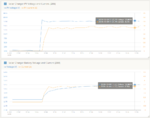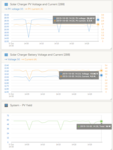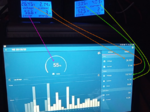I wasn't planning on another update on this thread until the monitors arrived, but thought this following point is worth mentioning when choosing a
Solar Controller....
Multi-stage charging
Batteries (talking Lead Acid here. Lithium are a different animal) require different stages when charging to treat them correctly for maximum operational life.
A decent
Solar Controller - be it
PWM or MPPT - should take account of this and operate in Bulk (CC), Absorption (CV) and Float modes when required. The correct Voltages for Absorption and Float modes should be documented by the
Battery manufacturer, and the maximum permissable current for Bulk model should also be documented.
Many
Solar Controllers, just like many Motorhome mains chargers are dumb chargers and don't have a float mode, so the
battery runs the risk of having a high voltage charge applied to it constantly all the time power is coming into the controller.
The chart below on my test setup with the old power transformers illustrate the kind of behaviour you should look for in a
Solar Controller

Power is applied.
The
Battery is fairly depleted, so is in Bulk Mode. The voltage gradually increases and the current is fairly steady (hence Bulk is also known as CC - Constant Current - Mode)
Then once the Voltage reaches the Absorption Voltage Setting, the Controller switches to Absorption Mode. The voltage is now steady (hence Absorption Mode is also called CV - Constant Voltage - Mode) and the current starts to decline as the
battery fills up.
Finally, the Controller switches to Float Mode. This can because the
battery is fully charged OR it may be because the controller has been in Absorption mode for a certain length of time.
(The maximum length of time a
battery should stay in absorption mode should also be documented by the
Battery Manufacturer. It is typically between 5 and 8 hours. In this case, Absorption Mode lasted 6 hours and then timed out. This helps protect the
battery and is a setting in the controller - this level of control is not that common and usually only found on the best models TBH).






